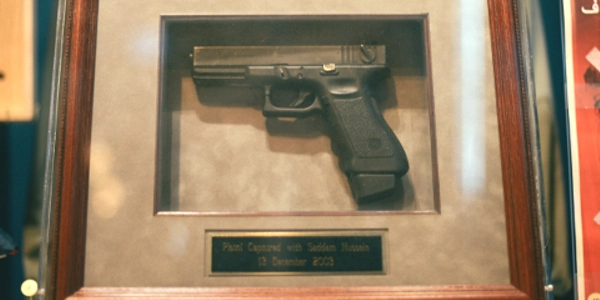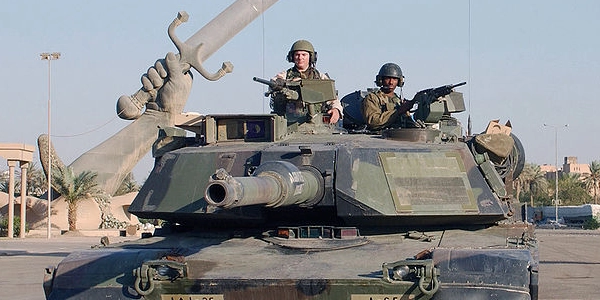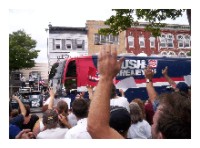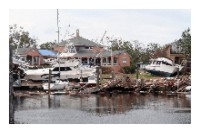
Photo above: World War II Memorial in Washington, D.C., opened April 29, 2004. Right: Court of Flags at the United Nations, Mateusz Stachowski, SXC Free Images.
Sponsor this page for $100 per year. Your banner or text ad can fill the space above.
Click here to Sponsor the page and how to reserve your ad.
-
Timeline
2003 - Detail
December 13, 2003 - Saddam Hussein, former leader of Iraq, is captured in a small bunker in Tikrit by the U.S. 4th Infantry Division.

What had started barely six months before when land operations for the 2nd Gulf War were started with bombings on Baghdad on March 19, 2003 and land operations one day later by troops from the United States, Great Britain, Australia, and Poland, would now end in an inauspicious way. Saddam Hussein, who had been threatening the world with support for terror acts, his invasion against Kuwait, and the bragadocio to contend he had weapons of mass destruction, biological, etc. was caught in a hole.
Operation Iraqi Freedom was over, in a technical sense, although United States and other troops would remain well past this date. Military intelligence that had agreed with Hussein and his stockpiles were wrong. There were only tenuous ties to the veracity of Hussein and the terrorists who had participated in the September 11, 2001 attacks on the World Trade Center, the Pentagon, and, except for the heros above Shanksville, other targets in Washington, D.C.
Captured in Tikrit
Saddam Hussein had been out of power since the fall of Baghdad on April 9, ending his twenty-four year reign. He had escaped the capital, followed by a coordinated manhunt. It took a sophisticated plan by the intelligence community to find the trail toward the deposed leader. Saddam Hussein's home was Tikrit, and upon the capture of Baghdad, the 4th Infantry Division was deployed there, joined by Tactical HUMINT Teams of interrogators, counterintelligence agents, and interpreters. They began to question the citizens of Tikrit, including Hussein's family members, for any tidbit of information that might lead to his whereabouts.
At first, Army leaders decided to attempt the capture of High Value Targets, Iraqi leaders under Hussein, thinking that if they were found, Hussein would be nearby. This did not work, as the Iraqi leadership had scattered far and wide throughout the nation. The First Brigade Combat Team of the 4th Infantry decided to use a "Three Tier Strategy," after that, focusing on five families that had known Saddam since childhood.
One family, the Muslit family, had particularly useful connections. With the capture of youngest brother on October 11, the network of friends and relatives who were assisting in his hiding began to come into place. Ibrahim Al-Muslit admitted that Saddam Hussein was hiding on a farm south of Tikrit. Two farmhouses were targeted on the Tigris River near Ad Dawr. The search of the houses did not locate him. Two cooperating HUMINT sources searched the surrounding area, revealing his hiding spot in a spider hole.

President Bush Address on the Capture, Cabinet Room, December 14, 2003, 12:15 p.m.
Good afternoon. Yesterday, December the 13th, at around 8:30 p.m. Baghdad time, United States military forces captured Saddam Hussein alive. He was found near a farmhouse outside the city of Tikrit, in a swift raid conducted without casualties. And now the former dictator of Iraq will face the justice he denied to millions.
The capture of this man was crucial to the rise of a free Iraq. It marks the end of the road for him, and for all who bullied and killed in his name. For the Baathist holdouts largely responsible for the current violence, there will be no return to the corrupt power and privilege they once held. For the vast majority of Iraqi citizens who wish to live as free men and women, this event brings further assurance that the torture chambers and the secret police are gone forever.
And this afternoon, I have a message for the Iraqi people: You will not have to fear the rule of Saddam Hussein ever again. All Iraqis who take the side of freedom have taken the winning side. The goals of our coalition are the same as your goals -- sovereignty for your country, dignity for your great culture, and for every Iraqi citizen, the opportunity for a better life.
In the history of Iraq, a dark and painful era is over. A hopeful day has arrived. All Iraqis can now come together and reject violence and build a new Iraq.
The success of yesterday's mission is a tribute to our men and women now serving in Iraq. The operation was based on the superb work of intelligence analysts who found the dictator's footprints in a vast country. The operation was carried out with skill and precision by a brave fighting force. Our servicemen and women and our coalition allies have faced many dangers in the hunt for members of the fallen regime, and in their effort to bring hope and freedom to the Iraqi people. Their work continues, and so do the risks. Today, on behalf of the nation, I thank the members of our Armed Forces and I congratulate them.
I also have a message for all Americans: The capture of Saddam Hussein does not mean the end of violence in Iraq. We still face terrorists who would rather go on killing the innocent than accept the rise of liberty in the heart of the Middle East. Such men are a direct threat to the American people, and they will be defeated.
We've come to this moment through patience and resolve and focused action. And that is our strategy moving forward. The war on terror is a different kind of war, waged capture by capture, cell by cell, and victory by victory. Our security is assured by our perseverance and by our sure belief in the success of liberty. And the United States of America will not relent until this war is won.
May God bless the people of Iraq, and may God bless America. Thank you," President George W. Bush.
Photo above: Saddam Hussein's pistol found during his capture on exhibit at the George Bush Presidential Library. Below: United States tanks from the 35th Army Regiment deployed in Baghdad, November 2003. Courtesy National Archives via Wikipedia Commons. Info source: "Operation Red Dawn Nets Saddam Hussein," 2013, USA/CoE Command History Office; "President Bush Addresses Nation on the Capture of Saddam Hussein," The White House, George W. Bush; Wikipedia Commons.

History Photo Bomb

The capture of this man was crucial to the rise of a free Iraq. It marks the end of the road for him, and for all who bullied and killed in his name. For the Baathist holdouts largely responsible for the current violence, there will be no return to the corrupt power and privilege they once held. For the vast majority of Iraqi citizens who wish to live as free men and women, this event brings further assurance that the torture chambers and the secret police are gone forever.
And this afternoon, I have a message for the Iraqi people: You will not have to fear the rule of Saddam Hussein ever again. All Iraqis who take the side of freedom have taken the winning side. The goals of our coalition are the same as your goals -- sovereignty for your country, dignity for your great culture, and for every Iraqi citizen, the opportunity for a better life.
In the history of Iraq, a dark and painful era is over. A hopeful day has arrived. All Iraqis can now come together and reject violence and build a new Iraq.
The success of yesterday's mission is a tribute to our men and women now serving in Iraq. The operation was based on the superb work of intelligence analysts who found the dictator's footprints in a vast country. The operation was carried out with skill and precision by a brave fighting force. Our servicemen and women and our coalition allies have faced many dangers in the hunt for members of the fallen regime, and in their effort to bring hope and freedom to the Iraqi people. Their work continues, and so do the risks. Today, on behalf of the nation, I thank the members of our Armed Forces and I congratulate them.
I also have a message for all Americans: The capture of Saddam Hussein does not mean the end of violence in Iraq. We still face terrorists who would rather go on killing the innocent than accept the rise of liberty in the heart of the Middle East. Such men are a direct threat to the American people, and they will be defeated.
We've come to this moment through patience and resolve and focused action. And that is our strategy moving forward. The war on terror is a different kind of war, waged capture by capture, cell by cell, and victory by victory. Our security is assured by our perseverance and by our sure belief in the success of liberty. And the United States of America will not relent until this war is won.
May God bless the people of Iraq, and may God bless America. Thank you," President George W. Bush.
Photo above: Saddam Hussein's pistol found during his capture on exhibit at the George Bush Presidential Library. Below: United States tanks from the 35th Army Regiment deployed in Baghdad, November 2003. Courtesy National Archives via Wikipedia Commons. Info source: "Operation Red Dawn Nets Saddam Hussein," 2013, USA/CoE Command History Office; "President Bush Addresses Nation on the Capture of Saddam Hussein," The White House, George W. Bush; Wikipedia Commons.









